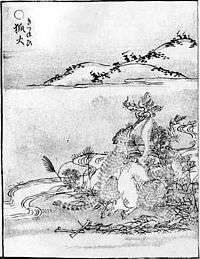Kitsunebi

Kitsunebi (狐火) is an atmospheric ghost light told about in legends all across Japan outside Okinawa Prefecture.[1] They are also called "hitobosu," "hitomoshi (火点し),"[2] and "rinka (燐火)."[3][4]
Overview
In the middle of night when people have fallen asleep,[5] a fire like in a paper lantern would flicker[6] and appear from between ten and several hundred in a line.[7] The line's length spans across up to one ri (about 500-600m), and depending on their number, when one thinks that they have increased, they would suddenly disappear then multiply once again.[7] Generally the color of the fire is red or orange,[7] but there have been several examples of witnesses that have seen blue flames.[8]
As its name implies, it has a close relation to kitsune (foxes). There are many theories stating that the glow is caused by the sighs or long breaths of a fox,[7][9] that it is caused by a fox knocking together its tails and causing a fire,[9] or that it is the glow from a ball that the fox possesses called the kitsunebi-dama (kitsunebi ball).[1][10] According to the assorted books Shokoku Rijindan from the Kanpō era, in the beginning of the Genroku era when a fisherman catches a kitsunebi with a net, the kitsunebi-dama would also be caught by the net. Since it would not shine at all at noon but shine brightly at night, it was highly valued for its illumination.[10]
It is said to appear in the hillsides where there are no roads and other places where there is no presence of humans. When it senses the presence of a human, it disappears.[2] On the other hand, there are also legends where it is said to follow a human anywhere.[11] It is often said that foxes trick humans; the kitsunebi would light up places where there are no roads and make the humans lose their way.[12] In those times, it was said to be possible to disperse it by kicking it up with one's feet.[13]
Although, there was a story in Nagano, where a certain lord and vassal was looking for a place to build a castle. A white fox lit up the path at night and guided the way for them to reach a suitable place for a castle.[14]
Just as how Masaoka Shiki composed haiku about winter and kitsunebi, they usually appear during the winter, but there have also been examples where they appear in the hot season of summer or in autumn.[15]
In the Dewa Province in Yamagata Prefecture and in Akita Prefecture, kitsunebi are called "kitsune taimatsu (狐松明, lit. "fox torch")." As its name implies, it is said to be a torchlight to prove lighting for a fox's marriage,[5] and is said to be a good omen.[16]
In Bizen, Okayama Prefecture, and the Tottori Prefecture, these atmospheric ghost lights are called "chūko (宙狐)."[17] Different from the average kitsunebi, they float at relatively low altitudes, and thus in Toyohara village, Oku District of Okayama, it is said that an old fox shapeshifted into a chūko.[17] Similarly, on Ryūgūjima, Tamatsu village, Oku District, the atmospheric ghost lights that appear at night with signs of coming rain that are about as big as paper lanterns are called chūko. Sometimes they would fall to the earth and illuminate the surroundings, and then finally disappear without a trace.[17] Enryō Inoue, a yōkai researcher from the Meiji period, applied the characters 中狐 to it, indicating the ones that fly high as "tenko" (天狐), and the ones that fly low as chūko.[18]
There is a theory that kitsunebi is another name for onibi,[4] but usually they are treated separately from onibi.
Kitsunebi in Ōji Inari

Ōji Inari of Ōji, Kita, Tokyo, is known to be the head of Inari Ōkami, it is also a famous place for kitsunebi.[7]
Formerly, the area around Ōji was all a rural zone, and on the roadside there was a big enoki tree. Every year, on the night of Ōmisoka, the foxes of Kanhasshū (all of the Kantō region) would gather below the tree, put on uniforms, call on their ranks, and visit the palace of Ōji Inari.[1][5][19] As the kitsunebi that can be seen on this occasion was quite a spectacle, it is said that the peasants around the area would count their numbers and used that to predict a good or bad harvest for next year.[1][19]
From this, enoki trees are also called "shōzoku enoki" (装束榎, lit. "costume enoki"), and it became a well known place, and even became a subject in Hiroshige Utagawa's work One Hundred Famous Views of Edo. The tree withered away in the Meiji period,[20] but a small shrine called the "Shōzoku Inari Jinja" remains next to the former second Ōji tram stop (now in front of the "horibun" intersection point),[20] and the area was previously called Enokimachi (榎町, lit. "enoki town").[19] As this area was part of a larger development plan, in 1993, on the evening of the annual Ōmisoka, an event was held called the "Ōji Kitsune's Procession."[21]
References
- 1 2 3 4 村上健司編著 『妖怪事典』 毎日新聞社、2000年、134頁。ISBN 978-4-620-31428-0。
- 1 2 とやま民俗 通巻10号 礪波地方怪怪譚(一) (怪異・妖怪伝承データベース 内) 2008年2月10日閲覧
- ↑ 伝承文学研究 通巻52号 歌、遊び、秘伝 (同上) 2008年2月10日閲覧
- 1 2 Yahoo!辞書
- 1 2 3 多田克己 『幻想世界の住人たち IV 日本編』〈Truth in fantasy〉 新紀元社、1990年、233頁。ISBN 978-4-915146-44-2。
- ↑ 民族 4巻3号 爐辺見聞 (怪異・妖怪伝承データベース 内) 2008年2月10日閲覧
- 1 2 3 4 5 草野巧 『幻想動物事典』 新紀元社、1997年、102頁。ISBN 978-4-88317-283-2。
- ↑ あしなか 通巻49号 伯耆大山を眺めつつ歩く (同上) 2008年2月10日閲覧
- 1 2 水木しげる 『妖鬼化 5 東北・九州編』 Softgarage、2004年、100頁。ISBN 978-4-86133-027-8。
- 1 2 日本随筆大成第2期 24巻 諸国里人談 (同上) 2008年2月10日閲覧
- ↑ 常民 27号 石川県鳳至郡門前町 調査報告書 (同上) 2008年2月10日閲覧
- ↑ 伝承文学研究 通巻52号 狐火 (同上) 2008年2月10日閲覧
- ↑ 伊那 51巻1号通巻896号 火の玉と狐火 (同上) 2008年2月10日閲覧
- ↑ 伊那 32巻1号/通巻668号 飯田の伝説 飯田の烏 (同上) 2008年2月10日閲覧
- ↑ 日本民俗 2巻12号 狐火 (同上) 2008年2月10日閲覧
- ↑ 『妖怪事典』 133頁。
- 1 2 3 『妖怪事典』 219頁。
- ↑ 水木しげる 『妖鬼化 4 中国・四国編』 Softgarage、2004年、41頁。ISBN 978-4-86133-016-2。
- 1 2 3 宮尾しげを『東京 昔と今 Ⅱ』 保育社カラーブックス 1963年、93頁。
- 1 2 装束稲荷神社(東京の石狐めぐり)、2011年8月26日閲覧。
- ↑ 王子狐の行列 公式ホームページ